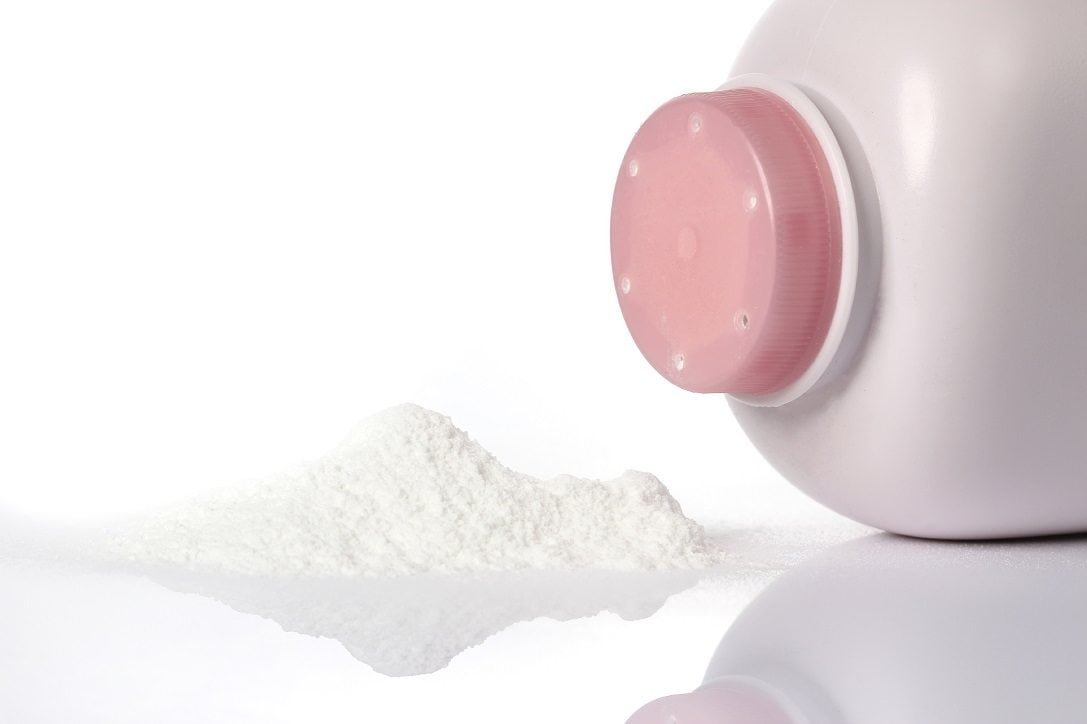Images of baby powder bring to mind infants, innocence, and coming out of the shower powdering oneself for a fresh, clean all-over feeling. Only in recent years has the public become aware that talcum and baby powder made by trusted manufacturers can be cancer-causing and in some cases lethal to the user due to the presence of asbestos particles.
What’s even more tragic is that these prominent companies knew about the toxicity of their products but denied the existence of a threat, in some cases, for more than 60 years.
Thousands of people have filed lawsuits against the largest baby powder manufacturer, Johnson & Johnson. Today the company has almost 15,000 talcum powder claims against it and in July 2018 experienced a judgment of $4.69 billion, including punitive damages, in a suit filed by 22 Missouri ovarian cancer victims.
Additionally, in 2018 and 2019 alone, more than $172 million was awarded to plaintiffs in jury verdicts and settlements of talcum powder lawsuits. The cases alleged asbestos contained in talc had caused ovarian cancer and mesothelioma (cancer of the lining of internal organs).
What About Other Victims of Talcum Powder Use?
Slater & Zurz is a law firm with offices in greater Akron, Cleveland, Canton as well as Columbus, Toledo and Cincinnati, whose attorneys are committed to getting justice for people injured by the misconduct of others. This includes powerful corporations that abuse the trust of loyal customers. These people have been unaware of company policies that disregard the rights of consumers, their health, and even their lives.
In this case, large corporations have marketed harmful—even lethal—products and when credible researchers link the products to disease, the big businesses insist there is no cause for alarm.
At Slater & Zurz the attorneys take the well-being of clients very seriously and have a proven track record of representing those injured by dangerous and defective products. If you are one of these individuals, possibly injured by talc use, or another defective product, please contact our offices immediately at 1-888-534-4850 and give a brief description of what has happened to you.
How Does Talc Cause Cancer?
Talc is a soft mineral that may be naturally contaminated with asbestos fibers in underground mines. When commercial powder containing talc is used on or near the genitals, (sprinkled on the body, on sanitary pads, on a diaphragm, or on bedsheets), fine airborne particles of asbestos can travel through the vaginal area to the fallopian tubes and ovaries. These particles become embedded in the ovarian tissue causing inflammation and the development of malignant tumors.
Several studies have shown that those who use talc as part of their normal hygienic routine have more than a 30% lifetime risk of being diagnosed with ovarian cancer compared to less than 2% of the rest of the population. (About 12% of women contract breast cancer during their lifetime.)
Eventually, some of these talc users develop other types of cancer including mesothelioma, endometrial cancer, cancer of the cervix (uterine), and the bladder. Those who inhaled the powder particles have claimed they contracted lung cancer or cancer of the larynx. Males who regularly powdered their genital area report talc use has resulted in testicular cancer.
Many of these victims attested to using talcum powder for years, but long-term use is not necessarily a qualification for filing a talcum powder lawsuit. Users for as little as four years have claimed bodily harm.
National health agencies report there is no safe level of exposure to asbestos and powder inhalation risks also include the development of pulmonary disorders, asthma, or chronic lung illnesses. Even trace amounts of asbestos in the human body have been found to be poisonous and infants exposed to asbestos-contaminated baby powder have suffered lung and respiratory problems.
Today talc is still found in many cosmetics, deodorants, medications, and household items such as spray paint, flea and tick spray, insecticides, chalk, clay, paper, crayons, joint compounds, and adhesives.
Cosmetic products containing talc are banned in many parts of Europe and are restricted for use in baby products in Canada. Manufacturers have recommended cornstarch as a natural replacement for talc, but experts warn potential respiratory problems from inhalation of airborne particles still exist.
History of Talcum Powder Controversy
Links between asbestos and talcum powder and between asbestos and ovarian cancer were reported in Lancet, a reputable medical journal as early as 1957.
In the early 1970s, the U.S. Food and Drug Administration commissioned a study of talc products and found carcinogen-causing asbestos in more than half of the Johnson & Johnson baby powder samples. But there was no pattern of asbestos’s presence and Johnson & Johnson demanded that the unfavorable findings were inconsistent and should not be made public.
Apparently, FDA officials acquiesced and the baby powder manufacturer was assured the study results would be kept relatively secret.
In 1982, researchers at the National Institute of Health found women using talcum powder during ovulation were at a 92 percent increased risk of developing ovarian cancer. An additional 21 studies concerning talcum powder’s possible carcinogenic properties were performed in the next 30 years. Nearly all of the research indicated women using talc products near the genitals were at increased risk of developing ovarian cancer.
An analysis published in 2003 combined data from 16 studies and found that although only certain types of ovarian cancer were implicated, talc and baby powder users specifically had a more than 30% lifetime risk of contracting one of these cancers.
In late 2018, the international news agency, Reuters, investigated a decade’s worth of Johnson & Johnson’s internal reports, company memos, and confidential documents dated from 1971 to the early 2000s, and found significant evidence that the major manufacturer of baby powder had longstanding knowledge of its products were contaminated.
It wasn’t until as late as the fall of 2019 that Johnson & Johnson recalled a single lot number of its baby powder after the FDA announced it had found trace amounts of asbestos. For the first time since the product was placed on the shelves in 1894, Johnson & Johnson acknowledged all was not perfect but the company did not add any warnings to its labels.
That same year the U.S. Justice Department and the Securities and Exchange Commission (SEC) placed the corporation under criminal investigation for misleading the public about the possible presence of asbestos fibers in their talcum powder. Company officials claimed insufficient evidence of danger and exulted over the safety of their products stating Johnson & Johnson “uses the purest, safest, pharmaceutical-grade talc on Earth.”
A South Dakota woman, Diane Berg, was the first to file suit against Johnson & Johnson in 2013. After discovering in 2006 that she had an advanced stage of ovarian cancer, which by 2013 had also reached her liver, Berg decided to do her own research on possible causes. Scrolling through websites, she discovered she had not suffered from infertility or endometriosis, precursors of the disease for others. Surprisingly, she found that talcum powder, a substance she had dusted between her legs daily for 30 years, emerged as the possible culprit.
Berg’s suit claimed Johnson & Johnson was negligent in not warning her about the possible effects of using the powder. She submitted a list of studies from as far back as 1971 as corroborating evidence of the link between talc use and her disease.
Johnson & Johnson tried to settle out of court with Berg for more than $1 million, but she refused because the company would not agree to a warning label on their talc products. A jury eventually ruled in Berg’s favor but she never personally profited financially from her victory.
Which Talcum Powders are Harmful?
Thousands of companies have used talc in their products in the last hundred years, according to the American Bar Association, but the top products and the brands implicated in ovarian cancer lawsuits to date have been:
- Johnson & Johnson Baby Powder and Shower to Shower
- Gold Bond Body Powder, Gold Bond No Mess Powder Spray, Gold Bond Extra Strength Body Powder
- Colgate-Palmolive talc
- Cashmere Bouquet
Several talc lawsuits have also been brought against the following companies:
- Imerys Talc North America (raw industrial and cosmetic talc makers)
- Whitaker, Clark & Daniels (raw cosmetic talc producers)
- Vanderbilt Minerals (raw industrial talc producers)
There have also been more than $150 million in talcum powder mesothelioma claims against various companies in recent years.
Support Grows for Link Between Talcum Powder and Cancers
Dozens of research studies involving thousands of women who have used talcum powder have concluded there is a significant link between talc usage and the development of cancer.
Among the organizations publicly acknowledging the risk of talc-based products as carcinogenic to humans are the National Cancer Institute, Harvard Medical School, the International Agency for Research on Cancer, the American Cancer Society, the International Journal of Gynecological Cancer, and the National Center for Health Research and Health Canada.
Filing a Talcum Powder Lawsuit
If you or a loved one is diagnosed with cancer of the reproductive system, especially ovarian cancer, or if you or a family member has developed mesothelioma, lung cancer, or respiratory ailments, there may be a link between your disease and talcum powder use—even if your use of the product was not recent.
If you suspect a connection, you need to speak with a lawyer experienced in filing product liability claims like the attorneys at Slater & Zurz. As you might envision, filing a claim can be a complex action and is not something you should decide you can do on your own.
While it may be true you may have a stronger claim if you used talc-based products more frequently for a longer duration, this is not necessarily the case.
Ohio has a statute of limitations on lawsuits of this type. The statute defines the time period in which you can file an action. There are many factors that affect when the clock starts to run depending on when a person is diagnosed with cancer and when they correlate it with talcum powder use.
Ovarian cancer is not regularly monitored for development like other cancers, and typically, is not discovered until it is in the later stages. At that point, the chances of survival for even five years are lower. In a worst-case scenario (someone has died from cancer linked to talc use), family members can file a talcum powder suit for wrongful death which generally has a two-year statute of limitations in Ohio. These are things an attorney versed in talcum powder lawsuits could explain more fully to a potential client.
It is important to note that Ohio does NOT have a “statute of repose” in product liability law which is a statute that totally cuts off certain legal rights if they are not acted upon by a specified deadline.
Why Choose Slater & Zurz
Upon hearing of the very large monetary awards and settlements in these cases, there are a lot of law firms out there trying to get a piece of the action and encourage people to file talcum powder suits. Not all of their attorneys are equally experienced and competent. Some of the reasons you should consider hiring Slater & Zurz if you make a talcum powder claim are listed here.
- Slater & Zurz has a history of success in personal injury and product liability lawsuits and has had billions of dollars in settlements for their clients in more than four decades the law firm has been in existence. Some of its members have been practicing for 50 years.
- The attorneys at Slater & Zurz are very focused on their clients. They take your best interests into account and do not just lump you in with a group of other plaintiffs. They will make sure important court deadlines are met, give you a clear explanation of your legal rights, and regular reports on the progress of your case. They also have the resources to hire expert witnesses to support your case.
- Slater & Zurz lawyers are familiar with talcum powder litigation and are confident they can show that big companies jeopardized countless consumers by putting profits ahead of safety.
For example, although Johnson & Johnson potentially lost $5 to $10 billion in lawsuits in recent years, they reported $16 billion in profits for the fiscal year 2016 alone. Slater & Zurz has worked on similar cases helping other law firms in Ohio and West Virginia with a massive legal action against DuPont, a company accused of chemically contaminating the residential water supply.
- Many potential clients are concerned about how they will be able to pay for representation. Slater & Zurz works on a “contingency fee” basis exclusively with these kinds of cases. This means the attorneys get paid only if you resolve your case favorably with a jury award or settlement. Slater & Zurz lawyers are skilled in determining the best result for you and your family. They do not back away from taking the matter to trial but will negotiate a settlement if that can be done fairly.
Where To Find Slater & Zurz
Slater & Zurz has convenient offices in Akron, Canton, Cleveland, Toledo, Columbus, and Cincinnati. If you cannot arrange to meet with us in Ohio, we will make plans to come to you. A review of your case is private and free of charge, and our attorneys will be able to advise you on how to proceed.
If you have further questions before arranging a visit, please contact us at 1-888-534-4850.







